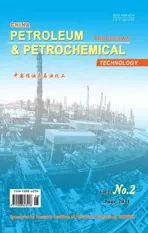Structural and Textural Transitions of the Zn-BDC Materials During Dehydration-Rehydration Process
2021-06-29DiaoYuxiaXinMudiShiYanqiangFuYingXuGuangtong
Diao Yuxia; Xin Mudi; Shi Yanqiang; Fu Ying; Xu Guangtong
(SINOPEC Research Institute of Petroleum Processing, Beijing 100083)
Abstract: A Zn-BDC (1,4-benzene-dicarboxylic acid) compound has been studied herein during reversibly adsorbing and desorbing water from a dimethyl formamide (DMF) solvent. The compound is structurally stable and can be reused.XRD, TG, SEM, and BET results show that the morphology, textural properties and phase can gradually transform from a non-porous compound into a porous Zn-MOF by being exposed in the steam of DMF with trace water. This dried phase[Zn(BDC)] is able to reversibly remove/uptake coordinating water molecules, which can provide Zn-BDC compound with the ability to dehydrate the solvent.
Key words: Zn-BDC; textural; transform; dehydrate
1 Introduction
Metal−organic frameworks (MOFs), also known as porous coordination polymers (PCPs), are constructed by coordination bonds between metal ions (or clusters)and organic linkers. MOFs are attracting more attention due to its extraordinary physical properties such as high specific surface areas, crystalline nature, highly ordered structure, high porosity, large cavity size, and controlled pore size[1-3]. Due to these characteristics,more and more applications have been explored in the fields of gas storage, separation, and catalysis[4-6]. As a kind of pioneer MOF, Zn and BDC can form MOF-2 with the composition Zn(BDC)(H2O)·DMF[7], MOF-5(or IRMOF-1) with the composition Zn4O(BDC)3under different synthesis conditions and zinc precursors[8]. The synthesis of metal–organic frameworks (MOFs) often exhibits unpredictable complexity, and the construction of MOFs with diverse structures remains a challenge[9-11].The versatile coordination modes of carboxylate anions lead to rich structures of MOFs. Schweighauser, et al. has reported the structure interconversion between MOF-5 and the MOF-2-like crystal[12]. Even in the same system,such as MOF-2, Edgar, et al. researched and assumed that there must be structural rearrangement during the removal and replacement of strong hydrogen bonding molecules, resulting in the solid-state, reconstructive transformations[13]. Such extremely facile single-crystal to single-crystal transformation driven by reversible removal/uptake of coordinating water molecules makes Zn-MOF an excellent water-sensing material[14]. Hereby we report the transformation of MOF-2 under the effect of water proportion. The conventional view is that the MOFs are unstable in water. But there is a breakthrough in generating a water-stable MOF KAUST-8 with unique water adsorption properties and outstanding recyclable dehydration capabilities[15]. The structure of Zn-BDC can be changed with the tunable proportion of coordinated water. The interconversion of Zn(BDC)and MOF-2 has derived inspiration that it has the function of solvent dehydration. Actually, in the fields of petrochemical, fine chemical, daily chemical and new energy sectors, anhydrous water-based organic solvents are indispensable[16].
2 Experimental
2.1 Synthesis
Zn-BDC compound was synthesized following a reported procedure[17]with minor changes. Typically, 0.262 g(1.0 mmol) of zinc nitrate hexahydrate (Zn(NO3)2·6H2O,99%, Alfa Aesar) and 0.166 g (1.0 mmol) of 1,4-benzenedicarboxylic acid (BDC, 98%, Alfa Aesar) were dissolved in 20 mL of dimethylformamide (DMF, 99.8%, BDH) in sequence. The resultant solution was transferred into a Teflon-lined stainless steel autoclave and allowed to react at 105 °C for 24 hours. The crystallized Zn-BDC product was collected by centrifugation. If the crystal was washed by distilled water for 6 times, the colorless crystal of Zn(BDC)(H2O)2could be obtained and was then naturally dried. Then the crystal with mother liquor was subjected to centrifugation followed by washing with analyticallypure DMF for 6 times. The colorless crystals of MOF-2 were finally obtained.
2.2 Catalyst characterization
The crystallinity of Zn-BDC samples was determined using powder X-Ray diffraction (PXRD) with a Bruker D8 Advance Lynx powder diffractometer. The textural properties of Zn-BDC catalysts were determined using nitrogen (N2) adsorption-desorption isotherm taken at 77 K with a Quantachrome instrument Autosorb-iQ analyzer. Prior to the measurements, Zn-BDC samples were degassed at 353 K and 393 K, respectively,overnight. The thermogravimetric analysis (TGA) of Zn-compound was performed using a TA Instruments TGA2950 thermogravimetric analyzer in a N2flow with isothermal holding at 298 K for 30 min, while being preheated at a heating rate of 10 °C/min to 973 K, at which it was maintained isothermally for 120 min. The SEM images were acquired by a Hitachi SU-70 high resolution analytical SEM.
3 Results and Discussion
3.1 The thermal behavior of Zn-BDC material
Two Zn-BDC compounds were analyzed by thermogravimetric technique. The TG curve of Zn(BDC)(H2O)2(Figure 1(a)) shows two events between 25 °C and 700 °C. The first weight loss up to 210 °C is assigned to the departure of terminal water species (observed:14.53%; expected: 13.28%). Extra water adsorbed on the powered sample might cause the slight difference in weight loss values[18]. The second weight loss from 440 °C to 540 °C corresponds to the removal of the organic linker together with the decomposition of the structure(observed: 63.06%; expected: 62.19%). The final residue is inorganic remains (observed: 30.7%; expected: 30.3%).For Zn(BDC)(H2O)·DMF (MOF-2), there are three weight drops according to the TG curves[19]. The first is related with the losing water (observed: 4.27%; expected: 5.59%),the second is the departure of DMF molecules (observed:20.14%; expected: 22.68%), the third one is associated with the removal of BDC together with the decomposition of the structure (observed 47.16%, expected 51.56%).The weight loss is consistent with the chemical formula of crystals. Compared to the thermal behavior of two Zn-BDC compounds, the same transition state was found between 200 — 400 °C during the heating process and it is easy to get the stable transition state compounds.Three characteristic weight losses are also observed after the intermediate Zn(BDC) is exposed in the DMF vapor with trace water, which has verified that it is converted to MOF-2 by being exposed to hydrogen bond-forming molecules such as water, or DMF. Its structure was further characterized by PXRD (Figure 2). After removal of the coordinated water and solvent molecules, XRD patterns showed that the crystallinity of intermediate is retained.
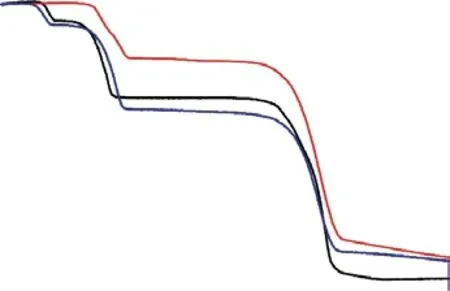
Figure 1 TGA curves of Zn(BDC)(H2O)·DMF (MOF-2),Zn(BDC)(H2O)2, and intermediate Zn(BDC) after having adsorbed water again
3.2 Crystal structure of Zn-BDC materials being in the as-synthesized, dehydrated, and rehydrated condition
PXRD patterns (Figure 2) clearly demonstrated that the pure Zn(BDC)(H2O)2was formed by washing with distilled water. The PXRD patterns of Zn(BDC)(H2O)2matched well with the main peaks previously reported which had indicated its “chain-like” nature[13]. The Zn ions adopted four-coordinated geometries. When it was heated at 200 °C for 2 hours in the N2atmosphere, an unknown crystal was formed with Zn and BDC serving as the main ingredients. According to the previous report[13],the removal of all solvent molecules can result in a stable intermediate crystalline [Zn(BDC)]. It can be seen from the PXRD patterns that the main peaks of [Zn(BDC)]between 10°—12° are similar as the simulated ones of Zn3(BDC)3(H2O)2·DMF, which has been synthesized via cathodic electrodeposition[20]. Upon heating, the coordinated water molecules were further evaporated and the metal/ligand ratio remained constant. During this process, Zn and BDC did not form the known MOF formation again. The similar phenomenon was found during the process of the MOF-5 formation[8], which demonstrated that MOF-2 was a dynamic structure as well as MOF-5. The intermediate could be rearranged into MOF-2 when it was exposed in the steam of DMF with trace water (with the water content being less than 0.2%).The PXRD pattern is uniform and is similar to that of assynthesized MOF-2. In this research, Zn(NO3)2·6H2O and BDC reacted on the analytically-pure DMF solvent with no additional water in the system, while still forming MOF-2 instead of MOF-5. Compared to the previous work, the only difference is the zinc source,which might be caused by the coordinated water in the Zn(NO3)2·6H2O[19].
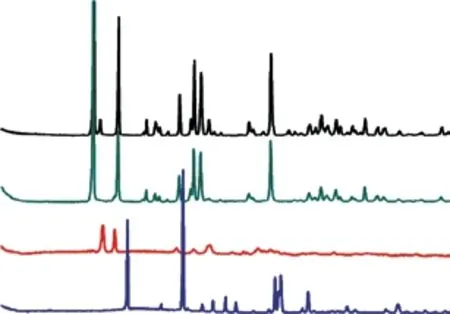
Figure 2 PXRD patterns of [Zn(BDC)(H2O)]·DMF (MOF-2) synthesized and washed by DMF, [Zn(BDC)(H2O)2]synthesized and washed by distilled water, intermediate Zn(BDC), Zn–BDC compound heated at 200 °C for 2 h in N2 atmosphere, [Zn(BDC)] with adsorbed water
3.3 The textural properties of Zn-BDC material during the structural transition
The textual properties of the samples were measured via N2adsorption-desorption isotherms. And their corresponding surface area and pore volumes are listed in Table 1. The BET surface areas of the MOF-2, [Zn(BDC)(H2O)2], and the intermediate [Zn(BDC)] were 247.689,0, and 0 m2/g, respectively. Figure 3 shows the adsorption isotherms of the [Zn(BDC)] materials, which were in excellent agreement with the reported MOF-2 values. The adsorption isotherm for the MOF-2 was an isotherm of type I, which indicated its ordered microporous structure(without hysteresis loop). Moreover, the isotherms were found to quickly rise at the low-pressure region (P/P0< 0.1), indicating that the open metal sites were easily accessible to the gas molecules. In the case of [Zn(BDC)(H2O)2], the surface area and the pore volumes decreased dramatically. Furthermore, the intermediate [Zn(BDC)]exhibited no obvious N2uptake. This phenomenon indicated that the texture of [Zn(BDC)] changed obviously, and the specific surface area and pore volume of the crystal reduced apparently with the loss of the guest coordinated molecules.
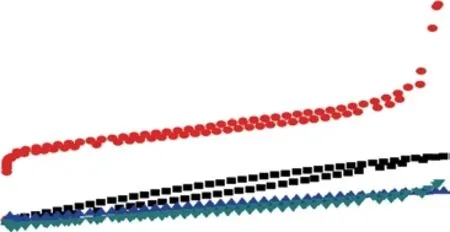
Figure 3 N2 sorption isotherms (measured at 77K) of[Zn(BDC)(H2O)2], [Zn(BDC)(H2O)]·DMF (MOF-2),MOF-2, and [Zn(BDC)(H2O)2]
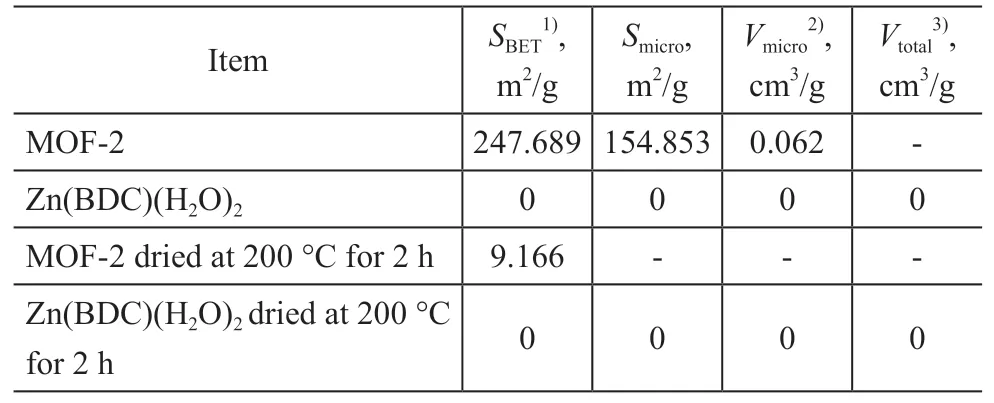
Table 1 Textural property of a series of Zn-BDC compounds
3.4 Morphological transition of the Zn-BDC material during dehydration of the solvent DMF
The morphologies of as-synthesized MOF-2, [Zn(BDC)(H2O)2], [Zn(BDC)], and the compound after adsorbent treatment were investigated by scanning electron microscopy (SEM). In order to observe the change of the surface of the crystals under different conditions, all the sample were not coated with inductive layers although there was a light charge because of the isolated nature.The SEM images show the obvious transition under the different states. Figure 4a is the crystal of [Zn(BDC)(H2O)2]. The crystal size is around 20 µm. The rough surface of the bare sample is covered after being exposed in the vapor of DMF with trace water. It is evident to confirm a change in the outer surface of each crystallite.Judging from the PXRD pattern, this is the newly formed MOF-2 crystal (Figure 4c). Meanwhile, the assynthesized MOF-2 possesses a relatively smooth surface without smaller MOF particles on the surface (Figure 4d).The cracks may be caused by loss of water when they are exposed to air. Furthermore, the particles remain the similar size under different experimental conditions. The transformation of Zn-BDC materials is summarized in Scheme 1.

Scheme 1 Reaction scheme summarizing the transformation of Zn-BDC materials
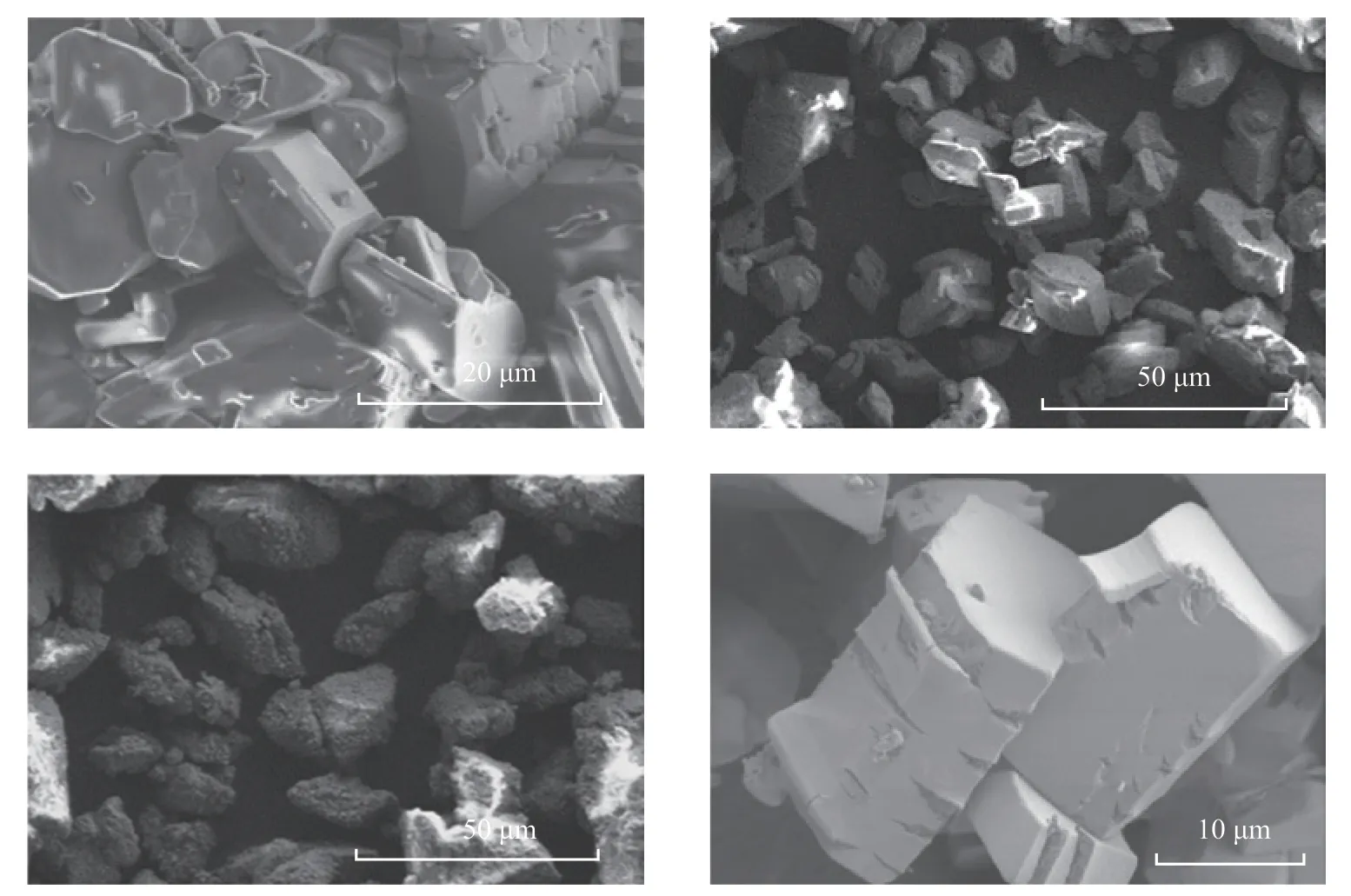
Figure 4 SEM images of: (a) as-synthesized Zn(BDC)(H2O)2, (b) intermadiate [Zn(BDC)], (c) [Zn(BDC)] exposed in vapor of DMF, and (d) as-synthesized [Zn(BDC)H2O]· DMF( MOF-2).
4 Conclusions
Synthesis of several Zn-BDC materials under the conditions investigated herein was shown to have been variably involved in the formation of a stable solidphase intermediate. The water and solvent molecular could affect the crystal phase according to the PXRD patterns, which would lead to a common intermediate by heating MOF-2 and [Zn(BDC)(H2O)2]. The intermediate[Zn(BDC)] material could show a reversible dehydrationrehydration process. The investigation of structural,textual properties and morphology of the crystal could reveal its reversible phase transformation with or without the solvent. By being exposed in the vapor of DMF containing trace water (with the water content being less than 0.2%), it can transform into MOF-2 and the textural structure can be recovered from nonporous material into microporous MOF. In addition, the morphology of this MOF has been confirmed by SEM. This study clearly demonstrated the structural changes between several crystals and differences in their properties, which might have potential applications in solvent separation process.
Acknowledgement:We gratefully acknowledge the financial support from the SINOPEC (G6001-20-ZS-0412).
杂志排行
中国炼油与石油化工的其它文章
- Effect of Acidity on Methylation of Benzene with Methanol Catalyzed by HZSM-5: A DFT Study
- Study on Reducing Injection Pressure of Low Permeability Reservoirs Characterized by High Temperature and High Salinity
- Heat Transfer and Kinetics Study of Moroccan Oil Shale Pyrolysis Process
- Application of a New Catalyst Deactivation Model for Residue Hydrotreating
- High-efficiency Extraction of Bitumen from Oil Sands Using Mixture of Ionic Liquid [Emim][BF4] and Dichloromethane
- Heat Exchanger Network Retrofit of Diesel Hydrotreating Unit Using Pinch Analysis
